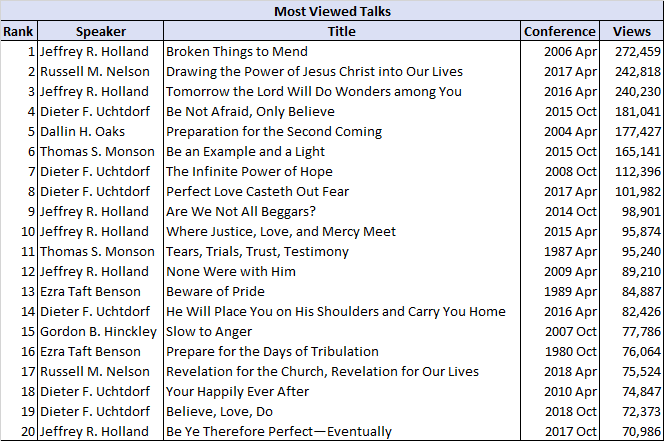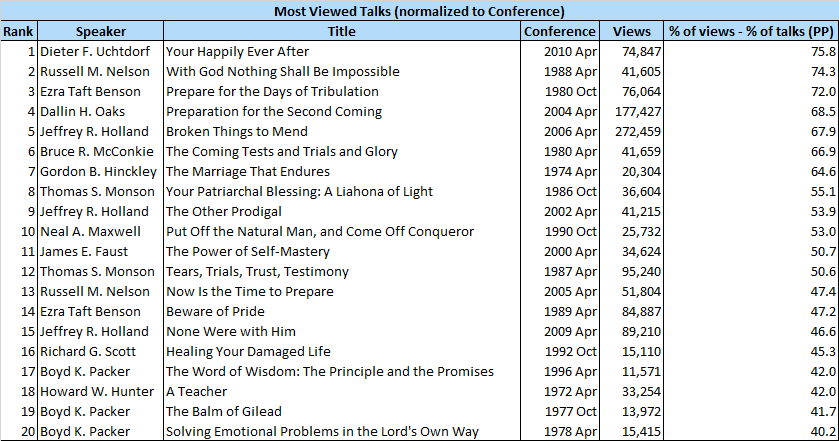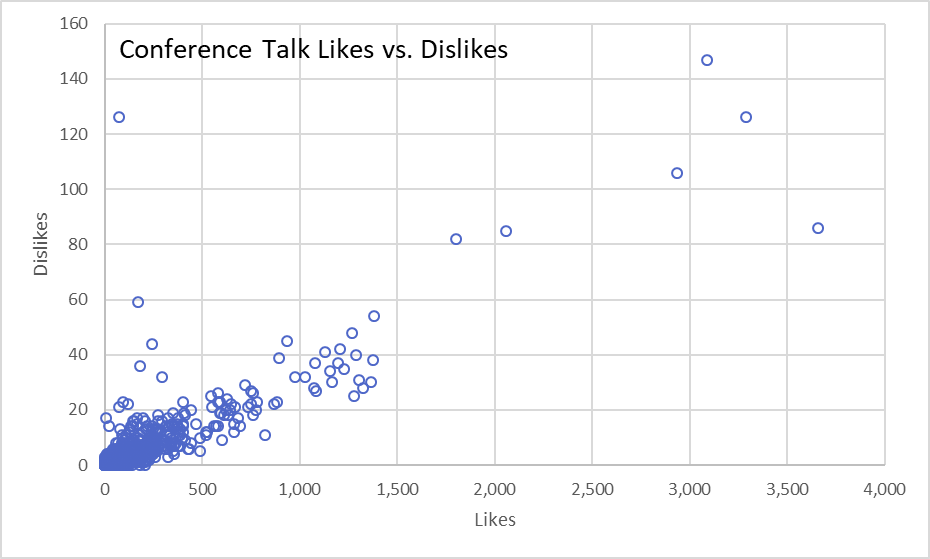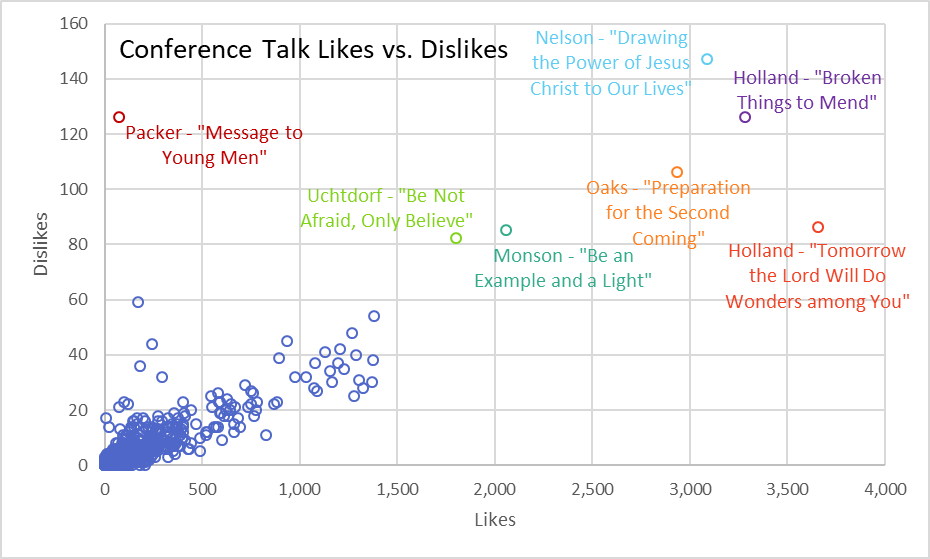A few weeks ago, I posted about the most viewed General Conference talks on YouTube. In that post, I looked at which speakers got the most views for their talks. In this post, I’ll look at which individual talks have gotten the most views.
Here’s the list of the top 20 in views.

Elder Holland has seven of the top 20, including #1 and #3. This probably isn’t a surprise considering that, as I found in the last post, his talks have the most views of any speaker. Elder Uchtdorf also does well with six in the top 20.
Looking at the topics of the talks, I think it’s interesting that a bunch of them seem to have a similar theme along the lines of “keep up hope even in the face of difficulty.” For example, the number one talk is Elder Holland’s “Broken Things to Mend,” where he talks about depression and despair. And he also bookends the list with #20, “Be Ye Therefore Perfect–Eventually,” where he encourages us not to be discouraged when we fall short of perfection. I think his “Tomorrow the Lord Will Do Wonders among You” also falls into this category along with (at least) Elder Uchtdorf’s “Be Not Afraid, Only Believe,” “The Infinite Power of Hope,” and “Perfect Love Casteth Out Fear.”
The top scolding talk is President Nelson’s “Drawing the Power of Jesus Christ into Our Lives,” where he reminds us that there’s no such thing as “the Atonement,” because that fails to explicitly mention Jesus Christ. He delivered this even before becoming Church President, so I guess it shouldn’t be surprising that he also made not using nicknames for the Church one of his top priorities once he took over the top spot. Also falling into this category is President Benson’s famous “Beware of Pride” talk, although really this talk feels less scolding to me because he seems to be addressing a more weighty issue.
The other common theme I see is that it looks like there are two talks on being ready for the Second Coming: then-Elder Oaks’s “Preparation for the Second Coming” and then-Elder Benson’s “Prepare for the Days of Tribulation.” I think the presence of this second talk on the list is particularly striking, as it’s from 1980 and the oldest talk on the list by seven years. As (at least in my experience) lessons and talks based on Conference talks rarely reach more than a few years into the past, it’s clearly striking a chord with somebody in an unusual way. I kind of wonder if this isn’t evidence of something like this talk being a favorite among some subgroup of Mormons, like doomsday preppers or something.
More recent Conferences have more views overall, though, so as in the last post, I’ll adjust each talk’s number of views by normalizing to the total number of views for the Conference in which it occurred. The adjusted measure is the difference (in percentage points) between the percentage of the views for its Conference that the talk received and the percentage of views it would have received if all talks in the Conference had gotten an equal number of views. For more detail, see the previous post. (Scroll to the paragraphs immediately following the graph titled “Total Views of Talks by Conference.”)
Here’s the adjusted top 20 list.

Some talks remain from the previous list, but there’s a fair amount of shuffling, and now much better representation from older Conferences. The Holland/Uchtdorf pro-hope juggernaut is broken up, and I really don’t see any big themes, with one exception. The preparation theme continues strong, with both talks from the previous list remaining, and taking over spots #3 and #4, and two more similarly-themed talks entering the list: Elder McConkie’s “The Coming Tests and Trials and Glory” at #6, and then-Elder Nelson’s “Now Is the Time to Prepare” at #13.
I also thought it might be fun to see the most-viewed talk for each speaker. To keep the list somewhat manageable, I included only speakers who have given at least five Conference talks in the 1971-2019 period. For each speaker, I ranked their talks using views normalized to Conference rather than unadjusted views. Here’s the list. Please note that there are some punctuation issues with a few of the talk titles that are inherited from the YouTube data (e.g., quotation marks spaced out too far, missing em dashes) that I didn’t bother to fix.
Some speakers–a lot of them, in fact–have a negative value for their highest percentage point difference. This just means that their most-viewed talk still received fewer views than it would have if all views for its Conference had been spread equally across talks. I think this result is actually pretty unsurprising, as it’s talks from the Q15 that typically get the most attention, and for speakers who are Seventies, for example, it’s unlikely that their talks will get many views at all.
In the last post, I found that Sister Sheri L. Dew had the highest number of views normalized to Conference per talk, so I was curious in particular to see what her most-viewed talk was. I am happy to see that it is not “Are We Not All Mothers?” Rather, it is “Are You the Woman I Think You Are?”
I have one last thing to look at. In the last post, I said that views and likes and dislikes were all so highly correlated that it wouldn’t be interesting to look at them separately, so I would just analyze views. There’s actually one outlying data point that violates this overall rule so dramatically that I wanted to call it out.
Here’s a scatterplot that shows, for each talk, likes versus dislikes.
The overall pattern is clear. Mostly as talks have more likes (moving from left to right along the horizontal axis), they also have more dislikes (moving from lower to higher along the vertical axis). In the lower left corner, there are a large number of talks that have very few of either. Toward the upper right, there are a few talks that have fairly large numbers of both. Note, though, that what qualifies as a “large number” is quite different for likes versus for dislikes. The horizontal and vertical axis scales are quite different. A talk has to get over 1000 likes to really stand out in likes, but only about 40 dislikes to stand out in dislikes. Over 90% of like and dislike responses are likes.
What stands out in this graph is one talk in the upper left part of the graph. It has a truly unremarkable number of likes (74), but it is tied for having the second-highest number of dislikes (126) of any talk in the data. Among other talks that generally get over 90% likes, it gets less than 40%. What talk do you think it is? What talk might qualify as the most disliked in the past 50 years of Conference?
I think you can probably guess.
It’s Elder Packer’s infamous “Message to Young Men” (a.k.a. “To Young Men Only,” or the “little factories” talk) given in October 1976 Conference. When I saw the outlying data point, I kind of wondered if this wouldn’t be what it was. I think there are few Conference talks that I know of that have had such bad effects as this one, what with its shaming of masturbation, shaming of sexuality in general, and tacit endorsement of violence against gay people.
The graph below is the same as the one above, except that I’ve labeled a few of the highest-like and highest-dislike talks.  Please don’t hesitate to comment if there are particular talks or speakers you have questions about, and I’ll supply answers if I have them.
Please don’t hesitate to comment if there are particular talks or speakers you have questions about, and I’ll supply answers if I have them.

I don’t see any difference between the first two tables.
Oops! Thanks, Last Lemming. I don’t know how I managed to use two copies of the same table instead of correctly using the two different ones, but it’s fixed now.
Thanks, Ziff! This is fun AND informative.
One thing I wondered about is the effect that having a talk highlighted/selected as the chosen talk for Church curriculum study has on the overall views? I have to think that the traffic for some of these talks is increased due to folks preparing their Sunday lessons; those that are viewed without that motivation, to me, could be considered more “pure” in their popularity.
Thanks, Hunter! And I’m sure you’re right that if a particular talk is chosen for the curriculum, that its numbers will go up immediately. This effect is probably negligible for the older talks, which makes the high scores for some of the preparedness talks even more striking.
.
Ziff, I always love these analyses of yours.
Thanks, Th.!